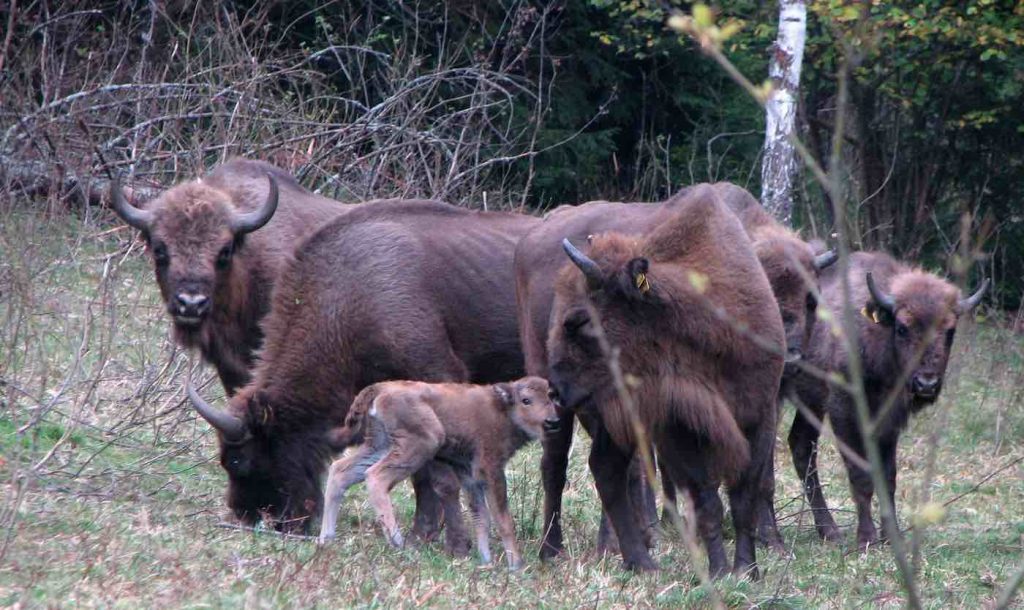
ByAndy Corbley for GoodNewsNetwork.org
A relative of the iconic beast that roams the American Great Plains is going to be released in an ancient forest in Kent, England—where they haven’t resided for 6,000 years.
But the four animals won’t be arriving by way of South Dakota or Wyoming because Europe has their own subspecies—the European wood bison.
The project is slated to begin in Spring of 2022, when a single male Bison bonasus and three females arriving from Poland and the Netherlands will be allowed to roam and reproduce naturally in the remaining wilds of Britain—and it is hoped that their presence will ignite a chain reaction throughout the forest.
Bison have the power to change a forest in dramatic ways; ways that humans don’t have the time or manpower for, and they are being considered as a possible solution to species loss in Great Britain.
The project called Wilder Blean, named for the reintroduction site, West Blean Woods, was organized by the Kent Wildlife Trust (KWT). The experiment isn’t just about bringing the bison back for the sake of something to look at, it’s part of a controlled trial to see if the large herbivore can reinvigorate forest ecosystems more productively than conservationists.
“European bison are being used in this project because they are ecosystem engineers, meaning that they are able to change their environment through their natural behaviors,” explains the KWT on their website. “Bison can change woodlands in a way that no other animal can.”
WATCH: 800-Pound Bison Performs Adorable ‘Happy Dance’ in Celebration of the First Day of Spring
Once ranging across the continent since the last Ice Age, European bison were hunted to extinction in the wild, but have since been reintroduced from captivity into several countries—mostly the forests of Poland, with smaller populations spread out across eastern and southern Europe.
Known as a keystone species, similar to krill in the ocean, tigers in India, or bees in a meadow, bison provide services that allow the ecosystems they live in to operate at a much higher capacity in terms of ecosystem activity. In conservation terms, a keystone species is one that plays a role in the preservation of other species, and the ecology as a whole.
Bison are the forestry experts
Bison kill weak or dead trees by eating their bark or rubbing against them to remove their thick winter fur. This turns the tree into food and habitat for insects, which in turn provide food for birds. The resulting pocket of sunlight allows new plants to grow, replenishing the woodland.
In an unexpected way, the attempted restoration of bison in the English ecosystem is more about halting England’s current species loss than it is about restoring some kind of Stone Age ecology to the island, and while the KWT anticipate a keystone species like Bison bringing additional eyes upon the value of conservation and the health benefits of interacting with great nature, the purpose of the project is to create healthier English forests that can support larger numbers of animals.
“Using missing keystone species like bison to restore natural processes to habitats is the key to creating bio-abundance in our landscape,” said Paul Hadaway from the KWT.

Funded by the People’s Postcode Lottery Dream Fund, which donated £1.1 million, Wilder Blean will cover 500 hectares (1,236 acres) of the largest area of ancient forest in the UK. Once the bison are established within a 150 hectare parcel, the KWT hopes to reintroduce “iron age pigs” and free-roaming longhorn cattle, in order to make West Blean Wood as near to the original product as possible.
Thousands of years ago, auroch—an enormous species of wild cattle, extinct as recently as the 1600s—would also have roamed the English countryside, and the longhorn cattle are ideal for attempting to replicate the unique effects that the aurochs no doubt had upon the landscape.
RELATED: Historic Deal to Protect Millions of Monarch Butterfly Habitat Acres is Unprecedented
In fact, European bison are likely hybrids of both the extinct subspecies called steppe bison and the auroch, because scientists have analyzed their DNA and found that the animals possess up to 10% of the genetic code of the auroch.
“The partners in the Kent project have long dreamed of restoring the true wild woodlands that have been missing from England for too long,” said Paul Whitfield, of Wildwood Trust, a conservation charity that will monitor the health and welfare of the bison.
“People will be able to experience nature in a way they haven’t before, connecting them back to the natural world around them in a deeper way.”